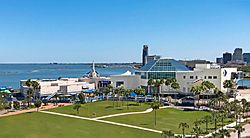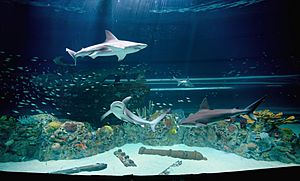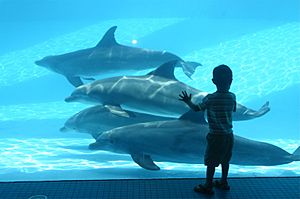Texas State Aquarium facts for kids

The Texas State Aquarium
|
|
| Date opened | July 6, 1990 |
|---|---|
| Location | Corpus Christi, Texas, United States |
| Land area | 6.3 acres (2.5 ha) |
| Coordinates | 27°48′50″N 97°23′32″W / 27.81389°N 97.39222°W |
| Volume of largest tank | 400,000 US gal (1,500,000 L) |
| Memberships | AZA |
| Website | texasstateaquarium.org |
The Texas State Aquarium is a special place in Corpus Christi, Texas, United States. It is a nonprofit aquarium that works to protect and help the amazing wildlife of the Gulf of Mexico. Since 1995, it has been approved by the Association of Zoos and Aquariums (AZA). This means it meets high standards for animal care and education. It is the biggest aquarium in Texas and one of the largest in the whole United States.
Contents
- Discover the Aquarium's Journey
- Explore Amazing Exhibits
- Caribbean Jungle Adventure
- H-E-B Caribbean Sea: Shark Encounter
- Vibrant Coral Reefs
- Mysterious Blue Hole
- Dolphin Bay: Meet the Dolphins
- Eagle Pass: Rescued Raptors
- Tentacles: Jellyfish Wonders
- Flower Gardens: A Reef Experience
- Hawn Wild Flight Theater: Birds in Flight
- Islands of Steel: Underwater Habitats
- Living Shores: Touch and Learn
- Otter Creek: Playful Otters
- Saving Sharks: Protecting Ocean Predators
- Stingray Lagoon: Touch a Ray
- Swamp Tales: Alligators and Turtles
- Tortuga Cay: Sea Turtle Rescue
- Exciting Programs and Learning
- Images for kids
- See also
Discover the Aquarium's Journey
The idea for the Texas State Aquarium started with a group called the Junior League of Corpus Christi. They first called it the Gulf Coast Zoological and Botanical Society. Later, in 1978, the name changed to the Corpus Christi Aquarium Association.
Becoming the Official Texas Aquarium
In 1986, the Texas Legislature officially named it the "Official Aquarium of Texas." This was a big honor, even though the aquarium did not receive money from the state. After more than 20 years of planning and building, the Texas State Aquarium finally opened its doors on July 6, 1990.
Helping Animals and Growing Big
In 1993, the aquarium became a place where injured animals could be cared for and healed. Two years later, in 1995, it earned its important accreditation from the Association of Zoos and Aquariums (AZA). This shows their commitment to excellent animal care.
On May 13, 2017, the aquarium opened a huge new area called Caribbean Journey. This expansion made the aquarium twice as big! It added exciting new exhibits, including a massive 400,000-gallon shark exhibit and a jungle filled with birds. They also added a fun 4D theater.
Explore Amazing Exhibits
The Texas State Aquarium has many exciting exhibits where you can see animals from different parts of the world.
Caribbean Jungle Adventure
Step into a natural jungle environment filled with flamingos and many free-flying birds. You might even spot a two-toed sloth! You can walk along jungle paths and look down into the water exhibits below.
H-E-B Caribbean Sea: Shark Encounter

This huge 400,000-US-gallon (1,500,000 l) tank is home to amazing creatures like sandbar sharks and stingrays. You can view them through the longest acrylic window in North America. There is also a cool acrylic tunnel you can walk through!
Vibrant Coral Reefs
This exhibit looks just like the Mesoamerican Barrier Reef System, which is off the coast of the Sian Ka’an Biosphere Reserve. You can see colorful fish like angelfish, goatfish, butterflyfish, and parrotfish. It's like diving into a real coral reef!
Mysterious Blue Hole
Discover a unique and hidden underwater world in the Blue Hole exhibit. This area shows deep underwater caves that can go down hundreds of feet. You can even step inside a special acrylic "bubble" to get a unique view of this mysterious habitat.
Dolphin Bay: Meet the Dolphins
This large 400,000-gallon (1,500,000 l) saltwater exhibit is home to four Atlantic bottlenose dolphins: Liko, Schooner, Shadow, and Kai. You can watch educational presentations where trainers teach you about dolphins and how to protect our oceans.
Eagle Pass: Rescued Raptors
All the amazing raptors in this exhibit were rescued and cared for at the Texas State Aquarium. They cannot go back into the wild, so they live here. One of the stars is Grace, a beautiful bald eagle.
Tentacles: Jellyfish Wonders
This 800-gallon (3,000 l) exhibit features many different types of jellyfish and sea nettle. Most of these fascinating creatures can be found right in the Gulf of Mexico.
Flower Gardens: A Reef Experience
This 40,000-gallon (150,000 l) exhibit looks like a coral reef. It is home to Atlantic tarpon, green moray eels, and cownose stingrays.
Hawn Wild Flight Theater: Birds in Flight
At this theater, you can watch amazing presentations featuring trained birds. You'll see parrots, hawks, owls, and falcons flying right over your head!
Islands of Steel: Underwater Habitats
Islands of Steel shows what life is like around an oil platform in the ocean. This 125,000-gallon (470,000 l) exhibit has nurse sharks, amberjack, Atlantic tarpon, grouper, a barracuda, and even a sand tiger shark. Many other species that live in the Gulf of Mexico can be found here.
Living Shores: Touch and Learn
At Living Shores, you can get up close and interact with animals in touch pools. You can gently touch hermit crabs, lightning whelks, and pencil urchins.
Otter Creek: Playful Otters
Two North American river otters live here! You can watch them play with each other and their trainers throughout the day. They are very active and fun to watch.
Saving Sharks: Protecting Ocean Predators
Saving Sharks is an interactive exhibit that teaches you all about sharks. It's designed to help you understand why these important ocean creatures need our protection.
Stingray Lagoon: Touch a Ray
This is the aquarium's largest outdoor touch pool. Here, you can gently touch Atlantic and cownose stingrays as they swim by.
Swamp Tales: Alligators and Turtles
Meet Bo, an 11-foot (3.4 m) American alligator, and six different kinds of freshwater turtles and tortoises in this exhibit.
Tortuga Cay: Sea Turtle Rescue
At Tortuga Cay, you can see rehabilitated sea turtles that cannot be released back into the wild. You can view them both above and below the water. The exhibit includes three green sea turtles (Squirt, Pickles, and Crush), one kemp's ridley sea turtle (Daisy), one hawksbill sea turtle (Hemingway), and a loggerhead sea turtle (Tiki).
Exciting Programs and Learning
The Texas State Aquarium offers many educational programs for kids and families.
Aquarium Discovery Programs
Schools can bring their students to these programs to learn all about the Gulf of Mexico environment.
Aquavision – Learning from Afar
If schools can't visit the aquarium, Aquavision helps! It uses online video calls to connect students with the animals and staff. This way, kids can learn from anywhere.
Overnights: Sleep with the Fish!
Imagine spending the night at the aquarium! Overnights allow children to sleep near the exhibits and get special behind-the-scenes tours.
Outreach Programs: Aquarium Comes to You
Aquarium staff can visit schools and give presentations right in the classroom.
Spring Break Mini-Camp
This camp is designed to help kids explore science, technology, engineering, and math (STEM). Activities include paddleboating and canoeing at their SeaLab facility.
Summer SeaCamp
SeaCamp is a week-long camp that also focuses on STEM. Kids can go fishing, visit the aquarium, do field activities, chat with ocean scientists, and even track a shark! It also includes an overnight stay at the aquarium.
Images for kids
-
The 400,000-gallon H-E-B Caribbean Sea exhibits sandbar sharks among a replica shipwreck.
See also
 In Spanish: Acuario del estado de Texas para niños
In Spanish: Acuario del estado de Texas para niños







